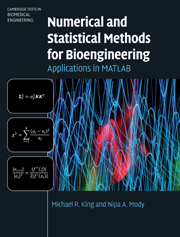Book contents
- Frontmatter
- Contents
- Preface
- 1 Types and sources of numerical error
- 2 Systems of linear equations
- 3 Probability and statistics
- 4 Hypothesis testing
- 5 Root-finding techniques for nonlinear equations
- 6 Numerical quadrature
- 7 Numerical integration of ordinary differential equations
- 8 Nonlinear model regression and optimization
- 9 Basic algorithms of bioinformatics
- Appendix A Introduction to MATLAB
- Appendix B Location of nodes for Gauss–Legendre quadrature
- Index for MATLAB commands
- Index
- References
5 - Root-finding techniques for nonlinear equations
Published online by Cambridge University Press: 05 June 2012
- Frontmatter
- Contents
- Preface
- 1 Types and sources of numerical error
- 2 Systems of linear equations
- 3 Probability and statistics
- 4 Hypothesis testing
- 5 Root-finding techniques for nonlinear equations
- 6 Numerical quadrature
- 7 Numerical integration of ordinary differential equations
- 8 Nonlinear model regression and optimization
- 9 Basic algorithms of bioinformatics
- Appendix A Introduction to MATLAB
- Appendix B Location of nodes for Gauss–Legendre quadrature
- Index for MATLAB commands
- Index
- References
Summary
Introduction
As previously discussed in Chapter 2, a system of linear equations can be expressed as Ax = b, where A and b are not functions of x. On the other hand, a system of equations written as Ax = b, in which A and/or bis a function of x, contains one or more nonlinear equations. A polynomial in x of order ≥ 2 has nonlinear dependency on the variable x and is an example of a nonlinear equation. Equations involving trigonometric and/or transcedental functions such as sin(x), cos(x), log(x), ex, and coth(x) are also nonlinear in x. The solution x of a nonlinear equation f(x) = 0 is termed a root of the equation or a zero of the function f(x). Application of numerical techniques to obtain the roots of nonlinear equations is the focus of this chapter.
Nonlinear equations that are not amenable to an analytical solution may be solved using iterative numerical schemes. A system of consistent linear equations will always yield a solution. In fact, linear equations that are consistent but not underdetermined will always have a unique solution, regardless of the technique used to solve the system of linear equations. On the other hand, a numerical method used to solve a nonlinear equation may not necessarily converge to a solution. Often, certain conditions must be met before a particular numerical technique can successfully produce a solution.
- Type
- Chapter
- Information
- Numerical and Statistical Methods for BioengineeringApplications in MATLAB, pp. 310 - 353Publisher: Cambridge University PressPrint publication year: 2010

